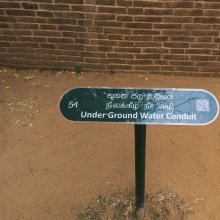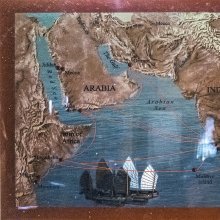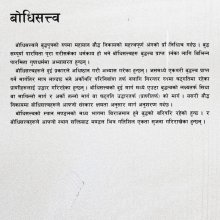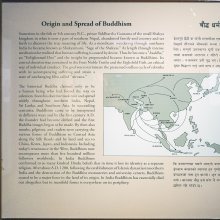Marga, Mārga, Mārgā: 34 definitions
Introduction:
Marga means something in Buddhism, Pali, Hinduism, Sanskrit, Jainism, Prakrit, the history of ancient India, Marathi, Hindi, biology. If you want to know the exact meaning, history, etymology or English translation of this term then check out the descriptions on this page. Add your comment or reference to a book if you want to contribute to this summary article.
Images (photo gallery)
(+3 more images available)
In Hinduism
Dharmashastra (religious law)
Source: Wisdom Library: Dharma-śāstraMārga (मार्ग) refers to “road”. Medhatīthi names three different types of roads (Manubhāṣya v. 7.185):
- those passing through the open country,
- those passing through marshy ground,
- and those passing through forests.
The term is used throughout Dharmaśāstra literature such as the Manusmṛti.

Dharmashastra (धर्मशास्त्र, dharmaśāstra) contains the instructions (shastra) regarding religious conduct of livelihood (dharma), ceremonies, jurisprudence (study of law) and more. It is categorized as smriti, an important and authoritative selection of books dealing with the Hindu lifestyle.
Purana and Itihasa (epic history)
Source: Cologne Digital Sanskrit Dictionaries: The Purana Index1) Mārga (मार्ग).—Highways and byways; diśāmārga, grāmamārga, rājapatha, sākharathyas, gṛharathyas, uparathyas, ghaṇṭāpatha, grahāntaram, vṛttimārga and prāgvaṃśa with their respective measurements. Avaskaram and Parīvāham are other dispositions of open spaces.1
- dik—20 dhanus in breadth.
- Grāma 20 dhanus in breadth.
- Sīma 10 dhanus in breadth.
- Rājapatha 10 dhanus in breadth.
- Śākhāratyas or streets 4 dhanus.
- Rathyoparathyas 3 dhanus.
- Upārathya rathas 2 dhanus.
- Janghāpatha 4 feet
- Gṛhāntaram (lanes) 3 feet.
- Dhṛtimārga 6 feet and more.
- Avaskāraparīvāra 1 ft. all round.2
2) Mārgā (मार्गा).—A Brahmavādin.*
- * Brahmāṇḍa-purāṇa II. 33. 19.
Mārga (मार्ग) refers to “pathways” (in the forest), according to the Rāmāyaṇa chapter 2.28. Accordingly:—“[...] soothening with kind words to Sītā, when eyes were blemished with tears, the virtuous Rāma spoke again as follows, for the purpose of waking her turn back: ‘[...] Pathways (mārga) covered with creepers and thorns, echoed with noise of wild cocks, are water-less and very difficult to enter. Hence dwelling in a forest is hardship’”.

The Purana (पुराण, purāṇas) refers to Sanskrit literature preserving ancient India’s vast cultural history, including historical legends, religious ceremonies, various arts and sciences. The eighteen mahapuranas total over 400,000 shlokas (metrical couplets) and date to at least several centuries BCE.
Natyashastra (theatrics and dramaturgy)
Source: Wisdom Library: Nāṭya-śāstra1) Mārga (मार्ग, “indication”) refers to ‘clear indication of the course of action’ one intends to follow. Mārga represents one of the thirteen garbhasandhi, according to the Nāṭyaśāstra chapter 21. Garbhasandhi refers to the “segments (sandhi) of the development part (garbha)” and represents one of the five segments of the plot (itivṛtta or vastu) of a dramatic composition (nāṭaka).
(Description of Mārga): Speaking out one’s real intention (lit. reality) is called Indication (mārga).
2) Mārga (मार्ग) refers to one of the twenty aspects of tāla (time-measure), according to the Nāṭyaśāstrahapter chapter 28. In musical performance, tāla refers to any rhythmic beat or strike that measures musical time. It is an important concept in ancient Indian musical theory (gāndharvaśāstra) traceable to the Vedic era.
3) Mārga (मार्ग) refers to a set of four rules used in the playing of drums (puṣkara) [with reference to Mṛdaṅga, Paṇava and Dardura] according to the Nāṭyaśāstra chapter 33. Accordingly, “the four mārgas relating to the strokes of the (covered) musical instruments are Aḍḍitā, Ālipta, Vitasta and Gomukha”.

Natyashastra (नाट्यशास्त्र, nāṭyaśāstra) refers to both the ancient Indian tradition (shastra) of performing arts, (natya—theatrics, drama, dance, music), as well as the name of a Sanskrit work dealing with these subjects. It also teaches the rules for composing Dramatic plays (nataka), construction and performance of Theater, and Poetic works (kavya).
Ayurveda (science of life)
Source: archive.org: Vagbhata’s Ashtanga Hridaya Samhita (first 5 chapters)Mārga (मार्ग) refers to the “three courses of a disease”, and is mentioned in verse 1.31 of the Aṣṭāṅgahṛdayasaṃhitā (Sūtrasthāna) by Vāgbhaṭa.—The term mārga (~lam) alludes to the three courses a disease may take in attacking the body: the stages of the outer path being roughly extremities, elements, and skin; those of the inner path, stomach and bowels; and those of the middle path, vitals and joints. Cf. I 12.44 sqq.

Āyurveda (आयुर्वेद, ayurveda) is a branch of Indian science dealing with medicine, herbalism, taxology, anatomy, surgery, alchemy and related topics. Traditional practice of Āyurveda in ancient India dates back to at least the first millenium BC. Literature is commonly written in Sanskrit using various poetic metres.
Jyotisha (astronomy and astrology)
Source: Wisdom Library: Brihat Samhita by VarahamihiraMārga (मार्ग) refers to the “course” (of heavenly bodies), according to the Bṛhatsaṃhitā (chapter 2), an encyclopedic Sanskrit work written by Varāhamihira mainly focusing on the science of ancient Indian astronomy astronomy (Jyotiṣa).—Accordingly, “A true Astrologer is also one who has thoroughly mastered the Science of Saṃhitā. It treats of the motions of the sun and planets; of their size, color, rays, brilliancy and shape and changes in the same of their disappearance and re-appearance; of their courses [i.e., mārga] and deviations therefrom; of their retrograde and reretrograde motions; of their conjunction with the stars and of their places among the stars and the like”.

Jyotisha (ज्योतिष, jyotiṣa or jyotish) refers to ‘astronomy’ or “Vedic astrology” and represents the fifth of the six Vedangas (additional sciences to be studied along with the Vedas). Jyotisha concerns itself with the study and prediction of the movements of celestial bodies, in order to calculate the auspicious time for rituals and ceremonies.
Shaktism (Shakta philosophy)
Source: Brill: Śaivism and the Tantric Traditions (shaktism)Mārga (मार्ग) refers to the “path (of existence)”, according to the King Vatsarāja’s Pūjāstuti called the Kāmasiddhistuti (also Vāmakeśvarīstuti), guiding one through the worship of the Goddess Nityā.—Accordingly, “[...] O goddess, I praise you with mind and speech. [...] Dwelling originally in the abode of Śiva, you multiply yourself sixfold and prepare the path of existence (bhāva-mārga) where you nurture wonderful and manifold creation with your own six forms. You shed moonlight on the path of Suṣumṇā that is charming due to the beautiful appearance of the six lotuses serving as [your] bases”.

Shakta (शाक्त, śākta) or Shaktism (śāktism) represents a tradition of Hinduism where the Goddess (Devi) is revered and worshipped. Shakta literature includes a range of scriptures, including various Agamas and Tantras, although its roots may be traced back to the Vedas.
Shaivism (Shaiva philosophy)
Source: Brill: Śaivism and the Tantric TraditionsMārga (मार्ग) refers to the “path (of the paśus)”, according to the 13th-century Matsyendrasaṃhitā: a Kubjikā-Tripurā oriented Tantric Yoga text of the Ṣaḍanvayaśāmbhava tradition from South India.—Accordingly, “Contempt [for these] will make him fall immediately here in this world and in the other world, O Pārvatī. He should not follow the path (mārga) of the paśus [i.e. that of the uninitiated] and he should not long for the leftover of paśus. He should strive for an encounter with the Yoginīs. He should not have sex with uninitiated women. He should not give leftovers to the uninitiated (paśu). He should never abuse women. [...]”.

Shaiva (शैव, śaiva) or Shaivism (śaivism) represents a tradition of Hinduism worshiping Shiva as the supreme being. Closely related to Shaktism, Shaiva literature includes a range of scriptures, including Tantras, while the root of this tradition may be traced back to the ancient Vedas.
Gitashastra (science of music)
Source: Shodhganga: Elements of Art and Architecture in the Trtiyakhanda of the Visnudharmottarapurana (gita)Mārga (मार्ग) refers to the “ways of playing drum”, according to the Viṣṇudharmottarapurāṇa, an ancient Sanskrit text which (being encyclopedic in nature) deals with a variety of cultural topics such as arts, architecture, music, grammar and astronomy.
There are four kinds of mārgas i.e., way of playing drum. These are—
- ahita,
- vitasta,
- ālipta and
- gomukhī.
In this context the Viṣṇudharmottarapurāṇa seems to follow the Nāṭyaśāstra as Nāṭyaśāstra also accepts four kinds of mārgas. According to the Nāṭyaśāstra as well as the Viṣṇudharmottarapurāṇa, the mārgas are related in connection with their projection of different sentiments. The instruments should be played in different mārgas for the depiction of different sentiments. For example—In the projection of śṛṅgāra and hāsya rasas, the instruments have to be played in ahitamārga. In vīra, raudra and adbhuta, the mārga of playing instruments should be vitastamārga. In karuṇa and śānta, the āliptamārga and in bībhatsa and bhayānaka, the gomukhīmārga are followed.
Gitashastra (गीतशास्त्र, gītaśāstra) refers to the ancient Indian science of Music (gita or samgita), which is traditionally divided in Vocal music, Instrumental music and Dance (under the jurisdiction of music). The different elements and technical terms are explained in a wide range of (often Sanskrit) literature.
Yoga (school of philosophy)
Source: ORA: Amanaska (king of all yogas): A Critical Edition and Annotated Translation by Jason BirchMārga (मार्ग) refers to the “path (of Yoga)”, according to the Mataṅgapārameśvaratantra (Mataṅgapārameśvara’s Yogapāda) verse 2.23-27.—Accordingly, while discussing ancillary and seated poses in Yoga: “[...] His head should always be upright. His gaze is towards heaven and earth, and its support is the tip of the nose. His eyes are slightly closed and he does not touch the teeth [of the upper jaw] with those [of the lower, nor] with the tip of his tongue which is located on the middle of the palate. O great sage, [this] Karaṇa has been explained fully and at length in regard to the path of Yoga (yoga-mārga-ukta)”.

Yoga is originally considered a branch of Hindu philosophy (astika), but both ancient and modern Yoga combine the physical, mental and spiritual. Yoga teaches various physical techniques also known as āsanas (postures), used for various purposes (eg., meditation, contemplation, relaxation).
Sports, Arts and Entertainment (wordly enjoyments)
Source: archive.org: Syainika Sastra of Rudradeva with English Translation (art)Mārga (मार्ग) refers to the “track (of footprints)” (of animals), according to the Śyainika-śāstra: a Sanskrit treatise dealing with the divisions and benefits of Hunting and Hawking, written by Rājā Rudradeva (or Candradeva) in possibly the 13th century.—Accordingly, “Hunting by the observation of footprints is that in which animals are tracked by their footprints (pada-mārga) and killed. [...]”.

This section covers the skills and profiencies of the Kalas (“performing arts”) and Shastras (“sciences”) involving ancient Indian traditions of sports, games, arts, entertainment, love-making and other means of wordly enjoyments. Traditionally these topics were dealt with in Sanskrit treatises explaing the philosophy and the justification of enjoying the pleasures of the senses.
In Buddhism
Mahayana (major branch of Buddhism)
Source: Wisdom Library: Maha Prajnaparamita SastraMārga (मार्ग, “path”) according to the 2nd century Mahāprajñāpāramitāśāstra (chapter VII).—“there are two types of path (mārga): that of the Śrāvakas (lesser vehicle) and that of the Bodhisattvas (greater vehicle). The four assemblies, bhikṣu, bhikṣuṇī, upāsaka, upāsīkā, form the path of the Śrāvakas; the bodhisattva-mahāsattvas form the path of the Bodhisattvas”.
Source: academia.edu: A Study and Translation of the GaganagañjaparipṛcchāMārga (मार्ग) (Cf. Bodhipatha) refers to the “way (of awakening)”, according to the Gaganagañjaparipṛcchā: the eighth chapter of the Mahāsaṃnipāta (a collection of Mahāyāna Buddhist Sūtras).—Accordingly: “[...] Then, son of good family, the Tathāgata Vimalaprabhānantaraśmirāja, having known the king Puṇyālaṃkāra’ thought, said this to Siṃhavikrāntagāmin: ‘By teaching the power of insight, supernatural knowledges , merits, and knowledges, son of good family, make all the assembly happy, make all abodes of Māra darken, illuminate the way of awakening (bodhi-mārga), satisfy all living beings, defeat all opponents, light the lamp of the dharma, purify all vices, and demonstrate the miraculous play of the Bodhisattva’”.

Mahayana (महायान, mahāyāna) is a major branch of Buddhism focusing on the path of a Bodhisattva (spiritual aspirants/ enlightened beings). Extant literature is vast and primarely composed in the Sanskrit language. There are many sūtras of which some of the earliest are the various Prajñāpāramitā sūtras.
Buddhist philosophy
Source: Wisdom Experience: Mind (An excerpt from Science and Philosophy)Mārga (मार्ग) refers to the “path (of knowledge)”.—By interpreting suffering as a problem of ignorance, Siddhārtha had embarked on a spiritual path that, in common with some other Indian traditions, came to be known as a “path of knowledge” (jñāna-mārga). For any path to knowledge, including all Indian Buddhist traditions, the fundamental goal of philosophy and contemplative practice is to uproot the confusion that underlies all suffering. Buddhist accounts often focus on exactly what constitutes ignorance—the foundational cognitive distortion that lies at the root of suffering—since identifying ignorance properly enables one to cultivate its antidote.
-
Tibetan Buddhism (Vajrayana or tantric Buddhism)
Source: OSU Press: Cakrasamvara SamadhiMārga (मार्ग, “path”) refers to the “path which leads to the end of suffering” and represents one of the “four noble truths”, according to Buddhist teachings followed by the Newah in Nepal, Kathmandu Valley (whose roots can be traced to the Licchavi period, 300-879 CE).—The primary teaching of Śākyamuni Buddha was the Catvāri Āryasatyāni (“The Four Noble Truths”, which are as follows: 1. duḥkha "life is suffering" 2. samudaya "suffering arises from craving" 3. nirodha "the cessation of craving is the end of suffering" 4. mārga "there is a path which leads to the end of suffering".
Mārga (the fourth truth), also known as the Āryāṣṭāṅgamārga ("The Eightfold Path"), consists of eight limbs divided into three parts as follows:
- samyagdṛiṣṭi (“right view”),
- samyaksaṃkalpa (“right intention”),
- samyagvāc (“right speech”),
- samyakkarmanta (“right action”),
- samyagājīva (“right livelihood”),
- samyagvyāyāma (“right practice”),
- samyaksmṛiti (“right mindfulness”),
- samyaksamādhi (“right meditation”).
Note: For a full explanation of the Four Noble Truths, Eightfold Path, and the four forms of suffering see Prebish; Keown (2010), Introducing Buddhism, ch. 3, pp. 42-53.

Tibetan Buddhism includes schools such as Nyingma, Kadampa, Kagyu and Gelug. Their primary canon of literature is divided in two broad categories: The Kangyur, which consists of Buddha’s words, and the Tengyur, which includes commentaries from various sources. Esotericism and tantra techniques (vajrayāna) are collected indepently.
General definition (in Buddhism)
Source: Wisdom Library: Dharma-samgrahaMārga (मार्ग, “path”) refers to the last of the “four noble truths” (caturāryasatya) as defined in the Dharma-saṃgraha (section 21). The Dharma-samgraha (Dharmasangraha) is an extensive glossary of Buddhist technical terms in Sanskrit (e.g., mārga). The work is attributed to Nagarjuna who lived around the 2nd century A.D.
Mārga or Mārgayajñāna refers to the “knowledge of path” and represents one of the “ten knowledges” (jñāna) as defined in the Dharma-saṃgraha (section 93).
In Jainism
General definition (in Jainism)
Source: The University of Sydney: A study of the Twelve ReflectionsMārga (मार्ग) refers to the “path (of bad conduct)”, according to the 11th century Jñānārṇava, a treatise on Jain Yoga in roughly 2200 Sanskrit verses composed by Śubhacandra.—Accordingly, “Having assented to your own births in the forest of life, the pain you have been suffering previously for a long time by roaming about on the path of bad conduct subject to wrong faith [com.—mithyātva-yukta-durnīti-mārga-bhrānta—‘by the one wandering on the path of misconduct connected with wrong faith’] is [like] an external fire. Now, having entered the self which is cherishing the end of all restlessness, wise, solitary, supreme [and] self-abiding, may you behold the beautiful face of liberation. [Thus ends the reflection on] difference [between the body and the self]”.
Synonyms: Patha, Pathin.

Jainism is an Indian religion of Dharma whose doctrine revolves around harmlessness (ahimsa) towards every living being. The two major branches (Digambara and Svetambara) of Jainism stimulate self-control (or, shramana, ‘self-reliance’) and spiritual development through a path of peace for the soul to progess to the ultimate goal.
India history and geography
Source: Shodhganga: A study of place names of Nalgonda districtMarga is a term designating ‘road’, used in the inscriptions of Andhra Pradesh.—These two appellations (marga and patha) are synonymous, standing for trade-communication routes or village roads. Understands pathaka as a term similar to a pargana of later days. Divisions with these appellations occur very rarely in Andhra Pradesh. Ane-marga was a division of the Kalyana Chalukyas and Ongeru-marga-vishaya was that of the Eastern Chalukyas. The Mayidavolu plates of the Pallava king Sivaskandavarman refer to Andhra-patha which might mean not an administrative unit, but the entire Andhra region ruled by the Pallavas. In Madhya Pradesh under the Vakatakas and the Sarabhapuriyas there were a large number of marga divisions.
Source: Cologne Digital Sanskrit Dictionaries: Indian Epigraphical GlossaryMārga.—(IE 8-1), abbreviation of Mārgaśīrṣa, Mārgaśira, etc. Note: mārga is defined in the “Indian epigraphical glossary” as it can be found on ancient inscriptions commonly written in Sanskrit, Prakrit or Dravidian languages.

The history of India traces the identification of countries, villages, towns and other regions of India, as well as mythology, zoology, royal dynasties, rulers, tribes, local festivities and traditions and regional languages. Ancient India enjoyed religious freedom and encourages the path of Dharma, a concept common to Buddhism, Hinduism, and Jainism.
Biology (plants and animals)
Source: Google Books: CRC World Dictionary (Regional names)1) Marga in Niger is the name of a plant defined with Cadaba farinosa in various botanical sources. This page contains potential references in Ayurveda, modern medicine, and other folk traditions or local practices It has the synonym Streblocarpus fenzlii Parl. (among others).
2) Marga in Nigeria is also identified with Cassia sieberiana It has the synonym Cassia kotschyana Oliv. (etc.).
Example references for further research on medicinal uses or toxicity (see latin names for full list):
· Journal of Ethnopharmacology (1983)
· Adansonia. (1981)
· Journal of Ethnopharmacology (2001)
· Journal of Ethnopharmacology (2005)
· Prodromus Systematis Naturalis Regni Vegetabilis (DC.) (1825)
· Bull. Mus. Natl. Hist. Nat.
If you are looking for specific details regarding Marga, for example health benefits, extract dosage, pregnancy safety, chemical composition, side effects, diet and recipes, have a look at these references.

This sections includes definitions from the five kingdoms of living things: Animals, Plants, Fungi, Protists and Monera. It will include both the official binomial nomenclature (scientific names usually in Latin) as well as regional spellings and variants.
Languages of India and abroad
Marathi-English dictionary
Source: DDSA: The Molesworth Marathi and English Dictionarymārga (मार्ग).—m (S) A road, path, way. 2 A religious order or persuasion. 3 fig. A manner, method, mode: also a fashion, custom, usage, practice. 4 A road unto or way of obtaining mōkṣa or svarga or some lōka or heaven or some future blessing. Three ways are enumerated:--karmamārga, upāsanā- mārga, jñānamārga. To these some add three others:--siddhāntamārga, yōgamārga, vairāgyamārga. mārga dharaṇēṃ To set out: to get on one's way. 2 To beset or infest the road; to sit waylaying. mārga phuṭaṇēṃ in. con. To find a way or an opening. Ex. khuṇṭalī samīrācī gati|| mārga na phuṭē cālāvayā||. mārga maḷaṇēṃ g. of o. To go to the village-boundary, and there, in fulfilment of some vow made to some divinity or idol, present offerings to it. This is done ordinarily in the name of dēvī, saṭhavī, kāḷikāī or kāḷēśvarī, jarīmarī (forms of dēvī), mhasōbā, and suchlike. 2 To journey to some country garden or grove, there to dine and make merry; to take a pic-nic-jaunt. mārgīṃ lāgaṇēṃ To get on the road (of one's proposed journey); to set out. 2 To be dying. 3 To get into the way (of doing or of understanding how to do): also to be entered upon or be begun--a work or matter.
Source: DDSA: The Aryabhusan school dictionary, Marathi-Englishmārga (मार्ग).—m A road Fig. A manner; a custom. A religious order. mārga dharaṇēṃ Set out. Sit way-laying. mārga phuṭaṇēṃ Find a way or an opening. mārgī lāgaṇēṃ Set out. Get into the way. Be dying.
Marathi is an Indo-European language having over 70 million native speakers people in (predominantly) Maharashtra India. Marathi, like many other Indo-Aryan languages, evolved from early forms of Prakrit, which itself is a subset of Sanskrit, one of the most ancient languages of the world.
Sanskrit dictionary
Source: DDSA: The practical Sanskrit-English dictionaryMārga (मार्ग).—[mṛj-śuddhau, mārg-anveṣaṇe ghañ vā]
1) A way, road, path (fig. also); मार्गो दशकरः प्रोक्तो ग्रामेषु नगरेषु च (mārgo daśakaraḥ prokto grāmeṣu nagareṣu ca) Śukra. 1.261; अग्निशरणमार्गमादेशय (agniśaraṇamārgamādeśaya) Ś.5; so विचारमार्गप्रहितेन चेतसा (vicāramārgaprahitena cetasā) Kumārasambhava 5.42; R.2.72; Uttararāmacarita 3.37.
2) A course, passage, the tract passed over; वायोरिमं परिवहस्य वदन्ति मार्गम् (vāyorimaṃ parivahasya vadanti mārgam) Ś.7.6.
3) Reach, range; मार्गातीतायेन्द्रियाणां नमस्ते (mārgātītāyendriyāṇāṃ namaste) Kirātārjunīya 18. 4.
4) A scar, mark (left by a wound &c.); भोगिवेष्टन- मार्गेषु (bhogiveṣṭana- mārgeṣu) R.4.48; ते पुत्रयोर्नैर्ऋतशस्त्रमार्गानार्द्रानिवाङ्गे सदयं स्पृशन्त्यौ (te putrayornairṛtaśastramārgānārdrānivāṅge sadayaṃ spṛśantyau) 14.4.
5) The path or course of a planet.
6) Search, inquiry, investigation.
7) A canal, channel, passage.
8) A means, way.
9) The right way or course, proper course; सुमार्ग, अमार्ग (sumārga, amārga)
1) Mode, manner, method, course; शान्ति° (śānti°) R.7.71.
11) Style, direction; इति वैदर्भ- मार्गस्य प्राणा दश गुणाः स्मृताः (iti vaidarbha- mārgasya prāṇā daśa guṇāḥ smṛtāḥ) Kāv.1.42; वाचां विचित्रमार्गाणाम् (vācāṃ vicitramārgāṇām) 1.9.
12) Custom, usage, practice; कुल°, शास्त्र°, धर्म° (kula°, śāstra°, dharma°) &c.
13) Hunting or tracing out game.
14) A title or head in law, ground for litigation; अष्टादशसु मार्गेषु निबद्धानि पृथक् पृथक् (aṣṭādaśasu mārgeṣu nibaddhāni pṛthak pṛthak) Manusmṛti 8.3.
15) A high style of acting, dancing and singing; अगायतां मार्गविधानसंपदा (agāyatāṃ mārgavidhānasaṃpadā) Rām.1.4.36. (com. gānaṃ dvividham | mārgo deśī ceti | tatra prākṛtāvalambi gānaṃ deśī | saṃskṛtāvalambi tu gānaṃ mārgaḥ).
16) (In dramaturgy) Hinting or indicating how anything is to happen.
17) (In geom.) A section.
18) The anus.
19) Musk.
2) The constellation called मृगशिरस् (mṛgaśiras).
21) The month called मार्गशीर्ष (mārgaśīrṣa).
22) Name of Viṣṇu (as the way to final emancipation).
-rgam A herd of deer; मार्गमदन्या वीथ्या नागवनं प्रयातो भर्ता (mārgamadanyā vīthyā nāgavanaṃ prayāto bhartā) Pratijña Y.1.
Derivable forms: mārgaḥ (मार्गः).
--- OR ---
Mārga (मार्ग).—a. Belonging to a deer (mṛga); मार्गमायूरकौक्कुटैः (mārgamāyūrakaukkuṭaiḥ) (māṃsacayaiḥ) Rām.2.91.7.
Source: Cologne Digital Sanskrit Dictionaries: Edgerton Buddhist Hybrid Sanskrit DictionaryMārga (मार्ग).—m. (Sanskrit id.; special uses, the first and third as in Pali magga), way; (1) aṣṭāṅga-m° (= Pali aṭṭhaṅga- magga), the (noble, ārya) 8-fold path: Mahāvyutpatti 996 etc.; the 8 steps (as in Pali) listed e.g. Mahāvyutpatti 997—1004, samyag- dṛṣṭi, -saṃkalpa, -vāc, -karmānta, -ājīva, -vyāyāma, smṛti, -samādhi; (2) daśāryagotra-mārgaṃ pratilabhate Laṅkāvatāra-sūtra 222.4, according to Suzuki the ten paths of discipline which belong to the noble family (of the Tathāgatas); what does this mean? the ten kuśala-karmapatha? Tibetan renders literally, ḥphags paḥi rigs kyi lam; (3) four kinds of śramaṇa (as in Pali, Sn 83—89, where this is made clear, and the magga-jina, -desaka or -desin, -jīvin, and -dūsin are defined), Mahāvyutpatti 5127—30, mārga-jina, conqueror of the way (of religion), -deśika, teacher of the way, -jīvin, living in the way, -dūṣin, defiling the way (by hypocrisy and wickedness).
Source: Cologne Digital Sanskrit Dictionaries: Shabda-Sagara Sanskrit-English DictionaryMārga (मार्ग).—m.
(-rgaḥ) 1. A road, a path or way. 2. Search, seeking, inquiry. 3. The anus. 4. Musk. 5. A way, a means. 6. The path of a planet. 7. Mode, method, course, manner. 8. Style, diction. 9. The month in which the moon is full in the asterism Mrigaśirsha, (November-December.) 10. The censtellation Mrigaśirsha. 11. (In geometry,) A section. E. mṛg to inquire, aff. aṇ; or mṛj to clean, aff. ghañ .
Source: Cologne Digital Sanskrit Dictionaries: Benfey Sanskrit-English DictionaryMārga (मार्ग).—i. e. A. mṛj + a (originally, the tracing out of game by a sporting dog), m. 1. Search. 2. Musk. 3. Trace, [Vikramorvaśī, (ed. Bollensen.)] 57, 12. 4. A road, [Pañcatantra] 122, 6; [Vikramorvaśī, (ed. Bollensen.)] 19, 18; way, [Pañcatantra] 98, 22; figuratively, [Pañcatantra] 167, 22; use, [Lassen, Anthologia Sanskritica.] 20, 18; title of law, [Mānavadharmaśāstra] 8, 3; mode. [Johnson's Selections from the Mahābhārata.] 11, 28. 5. The anus. B. mṛga + a, I. adj. Coming from deer, [Rāmāyaṇa] 2, 100, 63 Gorr. Ii. m. 1. The name of a month, November
— December. 2. The constellation Mṛgaśīrṣa.
Source: Cologne Digital Sanskrit Dictionaries: Cappeller Sanskrit-English DictionaryMārga (मार्ग).—[adjective] relating to game or deer. —[neuter] (±māṃsa) game, venison. [masculine] track, way, path, road, passage; mode, manner, [especially] right manner, proper course; custom, use; title or head ([jurisprudence]), stile, diction. mārgeṇa & mārgais through, along (—°).
Source: Cologne Digital Sanskrit Dictionaries: Monier-Williams Sanskrit-English Dictionary1) Marga (मर्ग):—[wrong reading] for mārga, [Āpastamba-gṛhya-sūtra]
2) Mārga (मार्ग):—[from mārg] m. (in most meanings [from] mṛga, of which it is also the Vṛddhi form in [compound]) seeking, search, tracing out, hunting, [cf. Lexicographers, esp. such as amarasiṃha, halāyudha, hemacandra, etc.]
3) [v.s. ...] (exceptionally also n.; ifc. f(ā). ) the track of a wild animal, any track, road, path, way to ([locative case] or [compound]) or through ([compound]), course (also of the wind and the stars), [Manu-smṛti; Mahābhārata] etc. (mārgaṃ-√dā or yam, with [genitive case] of [person], to give up the way to, allow to pass; māgeṇa ifc. = by way of id est. through, across or along; with √yā, to go the way of id est. suffer the same fate as; mārgais ifc., through; mārgāya, with [genitive case], in order to make way for any one; mārge, by the wayside or on the way; with pra-√cal, to set out on one’s way; nijamārgaṃ-√gam, to go one’s way)
4) [v.s. ...] a walk, journey, [Varāha-mihira’s Bṛhat-saṃhitā]
5) [v.s. ...] reach, range, [Kirātārjunīya]
6) [v.s. ...] a scar, mark (left by a wound etc.), [Raghuvaṃśa]
7) [v.s. ...] (in [medicine]) a way, passage, channel (in any part of the body, [especially] the intestinal canal, anus)
8) [v.s. ...] a way, expedient, means, [Kāmandakīya-nītisāra; Kathāsaritsāgara] (mārgeṇa, by means of [Varāha-mihira’s Bṛhat-saṃhitā])
9) [v.s. ...] a way, manner method, custom, usage, [Upaniṣad; Yājñavalkya; Mahābhārata] etc.
10) [v.s. ...] the right way, proper course, [Mahābhārata; Harivaṃśa] (cf. āmārga)
11) [v.s. ...] (with Buddhists) the way or path pointed out by Buddha for escape from the misery of existence (one of the 4 noble. truths), [Monier-Williams’ Buddhism 44] (cf. āryāṣṭāṅga-m)
12) [v.s. ...] a title or head in law, ground for litigation, [Manu-smṛti viii, 3, 9 etc.]
13) [v.s. ...] a way of speaking or writing, diction, style, [Kāvyādarśa; Sāhitya-darpaṇa]
14) [v.s. ...] a high (opp. to ‘vulgar’) style of acting or dancing or singing, [Inscriptions; Daśarūpa]
15) [v.s. ...] (in [dramatic language]) pointing out the way, indicating how anything is to take place, [Daśarūpa; Sāhitya-darpaṇa]
16) [v.s. ...] (in [astrology]) the 7th mansion, [Varāha-mihira’s Yogayātrā]
17) [v.s. ...] (in [geometry]) a section, [Horace H. Wilson]
18) [v.s. ...] musk, [cf. Lexicographers, esp. such as amarasiṃha, halāyudha, hemacandra, etc.] (cf. mṛga-mada)
19) [v.s. ...] the month Mārgaśīrṣa (November-December), [Rājataraṅgiṇī]
20) [v.s. ...] the constellation Mṛga-śiras, [cf. Lexicographers, esp. such as amarasiṃha, halāyudha, hemacandra, etc.]
21) [v.s. ...] Name of Viṣṇu (as ‘the way’, [scilicet] to final emancipation), [Mahābhārata]
22) [v.s. ...] mf(ī)n. belonging to or coming from game or deer, [Rāmāyaṇa; Varāha-mihira; Suśruta]
Source: Cologne Digital Sanskrit Dictionaries: Yates Sanskrit-English Dictionary1) Mārga (मार्ग):—(ki) mārgati yati 1. a. To make or prepare; to go; to feather an arrow. (ka, ña) mārgayati, te 1. 10. c. To seek, search after.
2) (rgaḥ) 1. m. A road; search; musk; a month; anus; a constellation.
Source: DDSA: Paia-sadda-mahannavo; a comprehensive Prakrit Hindi dictionary (S)Mārga (मार्ग) in the Sanskrit language is related to the Prakrit word: Magga.
[Sanskrit to German]
Sanskrit, also spelled संस्कृतम् (saṃskṛtam), is an ancient language of India commonly seen as the grandmother of the Indo-European language family (even English!). Closely allied with Prakrit and Pali, Sanskrit is more exhaustive in both grammar and terms and has the most extensive collection of literature in the world, greatly surpassing its sister-languages Greek and Latin.
Hindi dictionary
Source: DDSA: A practical Hindi-English dictionaryMārga (मार्ग) [Also spelled marg]:—(nm) way, path, route, course; road; track; passage, outlet; -[kara] toll, toll-tax; -[(pra)darśaka] a guide; pioneer; -[pradarśana] guidance; —[kholanā/praśasta karanā] to open the way, to open an avenue; —[banānā] to pave the way; —[meṃ roḍe aṭakānā/bichānā] to create impediments in the way of; —[rokanā] to block the way; —[se] via; —[se bhaṭakanā/haṭanā] to deviate from one’s course, to stray.
...
Kannada-English dictionary
Source: Alar: Kannada-English corpusMārga (ಮಾರ್ಗ):—
1) [noun] a way beaten, formed or trodden by the feet of persons or animals or a long, narrow stretch with a smoothed or paved surface, made for traveling by motor vehicle, carriage, etc.; a path; a way; a road.
2) [noun] a customary manner of procedure or a regular way of behaving.
3) [noun] a long-established custom or practice; a tradition.
4) [noun] careful, systematic, patient study and investigation.
5) [noun] Mārgaśira, the ninth month in the HIndu lunar calendar (November-December).
6) [noun] the classical style in literature (particular to a language), dance and music (particular to their individual systems).
7) [noun] a means (as to know, get, achieve, etc. something); an expedient.
8) [noun] a discoloured patch or mark left on the skin by wound after it is healed.
9) [noun] (astron.) the star Lambda Orion in the constellation Orion.
10) [noun] Viṣṇu.
11) [noun] a strong-smelling substance secreted in a glandular sac under the skin of the abdomen of the male musk deer, and used in perfumery; musk.
12) [noun] (Dvaita phil.) one of the four types of salvations.
13) [noun] (Buddh.) the way or path suggested by Buddha for escape from the miserty of existence (considered as one of the four noble truths).
14) [noun] ಮಾರ್ಗಕ್ಕೆ ತರು [margakke taru] mārgakke taru to put a person, administration of an institution, etc. to the right or desirable course.
Kannada is a Dravidian language (as opposed to the Indo-European language family) mainly spoken in the southwestern region of India.
See also (Relevant definitions)
Starts with (+125): Marga Traya, Marga-adaya, Marga-adayam, Margabandhana, Margabheda, Margabhranta, Margachitr, Margacitra, Margadakshaka, Margadarshaka, Margadarshaki, Margadarshana, Margadarshi, Margadayini, Margadde, Margade, Margadeshika, Margadhenu, Margadhenuka, Margadranga.
Ends with (+320): Abhijatamarga, Abhilapamarga, Abhramarga, Adamarga, Addamarga, Adharamarga, Adhomarga, Adhvamarga, Adimarga, Agamarga, Agastyamarga, Aghoramarga, Aharanihsaranamarga, Ahatamarga, Ahitamarga, Aindramarga, Akamarga, Akashamarga, Akashe-tara-marga, Akshunna Marga.
Full-text (+671): Jalamarga, Margadhenu, Indramarga, Gudhamarga, Kulamarga, Margashodhaka, Trimarga, Vitasta, Alipta, Margaharmya, Apamarga, Vimarga, Rajamarga, Margarodhin, Bhaktimarganirupana, Nirmarga, Pratimargam, Margashakhin, Margavati, Ravimarga.
Relevant text
Search found 128 books and stories containing Marga, Mārga, Mārgā; (plurals include: Margas, Mārgas, Mārgās). You can also click to the full overview containing English textual excerpts. Below are direct links for the most relevant articles:
Kuntaka’s evaluation of Sanskrit literature (by Nikitha. M)
3.6. Styles or Mārgas < [Chapter 1 - Vakroktijīvita: A Synoptic Survey]
8. Pādatāḍitaka in Kuntaka’s treatment < [Chapter 4 - Kuntaka’s evaluation of Sanskrit Plays of other Poets]
3. Harivijaya in Kuntaka’s treatment < [Chapter 3 - Kuntaka’s estimation of Mahākāvyas of other Poets]
Brihad Bhagavatamrita (commentary) (by Śrī Śrīmad Bhaktivedānta Nārāyana Gosvāmī Mahārāja)
Verse 2.2.133 < [Chapter 2 - Jñāna (knowledge)]
Verse 2.4.53-54 < [Chapter 4 - Vaikuṇṭha (the spiritual world)]
Verse 2.2.206 < [Chapter 2 - Jñāna (knowledge)]
Vastu-shastra (2): Town Planning (by D. N. Shukla)
Garga Samhita (English) (by Danavir Goswami)
Verses 4.1.37-38 < [Chapter 1 - The Story of the Personified Vedas]
Verse 5.5.27 < [Chapter 5 - Śrī Kṛṣṇa’s Entrance Into Mathurā]
Verse 4.1.22 < [Chapter 1 - The Story of the Personified Vedas]
Natyashastra (English) (by Bharata-muni)
Chapter XXXIII - On Covered Instruments (avanaddha)
Chapter XXXI - On the Time-measure (tāla)
Alamkaras mentioned by Vamana (by Pratim Bhattacharya)
6: Alaṃkāra-śāstra according to Daṇḍin (8th century) < [Chapter 2 - The concept of alaṃkāra in Sanskrit Poetics]
3: Definition of Anuprāsa Alaṃkāra < [Chapter 3 - Śabdālaṃkāras mentioned by Vāmana]
Related products










